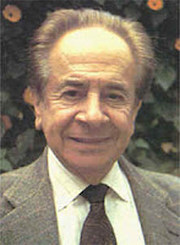This article is part of the series "A Moment in History" where we honor those who have contributed to the growth of medical knowledge in the areas of anatomy, medicine, surgery, and medical research.
Dr. Salomón Hakim (1922 - 2011). Dr. Hakim was born in the city of Barranquilla, Colombia. He started medical school in 1944 and elected neurosurgery as his specialty. He had special interest in electricity and physics, which he used extensively in his research.
In 1957 Dr. Hakim was exposed to a strange case of a young man with what was known then as "symptomatic occult hydrocephalus". Until that time the accepted knowledge was that hydrocephalus was due to an increase in intracranial pressure of different etiology. The problem was that the young man had normal pressure, yet had a hydrocephalus and enlarged ventricles. Dr. Hakim applied his knowledge of physics and laid the conceptual basis for what became known as "Normal Pressure Hydrocephalus" a condition until then unrecognized and that is found in aging patients with dementia, Alzheimer's, and other pathologies.
Working at home, Dr. Hakim developed a pressure-regulating shunt to drain the excess cerebrospinal fluid (CSF) from the ventricular system of the brain. These valves were later produced by medical industry. His son Carlos has continued his legacy and now the Hakim programmable valve is one of the best CSF shunt systems in the world.
I had the pleasure of meeting Dr. Hakim in 1993 in Santiago, Chile, and again later in the US, as he presented his valve system to a group of neurosurgeons. This short article does not do justice to the physician, researcher, and family man. I encourage you to read more in the following links. Dr. Miranda
Sources:
1. "Salomon Hakim and the Discovery of Normal-Pressure Hydrocephalus"Wallenstein, MB; McKhann, GM. Neurosurgery (2010) 67;1:155-159
2. "The Reprieve: Reversing Dementia"online article by Rose Tibayan
3. "Salomon Hakim, alma y vida de cient?fico"Article by Paulina Ortiz
4. "Salomon Hakim: Un milagro de Colombia para el mundo"
Original image courtesy of The Hydrocephalus Association




